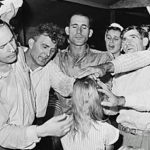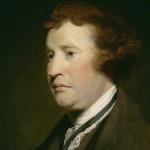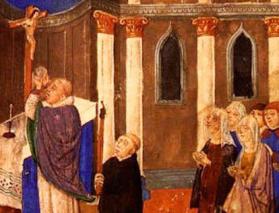Henry de Candole was one of the leaders of the early liturgical movement in the Church of England. In his 1935 The Sacraments and the Church, he explores “the corporate nature of Christianity” and places sacramental theology firmly within ecclesiology. He hits many, many of the right notes.
He begins by asking whether the church is a “self-chosen” or a “natural” society. While acknowledging the element of choice, he insists (surprisingly to some, no doubt) that the church is a natural society. He argues, in part, “on the day of Pentecost the three thousand converts did not found the community. It existed already and they were ‘added unto’ it” (5).
Pentecost fulfills the ministry of Jesus, which focused on the formation of a “brotherhood.” He begins with “a large, loose band of followers; then the Twelve, upon whom He concentrates His care and attention increasingly, to whom He commits certain special ceremonies, Washing and the Supper. If any many wanted to form a society to perpetuate his teaching, these are the actions he would take – and these Christ did take” (7).
And Jesus’ ministry is in keeping with the corporate., social character of Judaism (8). Jesus didn’t come to found a society; He came to refound Judaism.
In short, “it is not by a number of individuals coming together that a society of the ‘self-chosen’ type is formed to create a Church; the Church is already there, not a voluntary association, but a God-given, in that sense, a ‘natural,’ because God-created, Christ-refounded community, the people of God, or the Body of Christ” (10).
“Sacramentalism” is rooted in this corporate, “bodily” character of the Christian faith. For an individual, “the force of his inner self remains unexercised unless it is embodied in activity through his body. Self-revelation, personal activity upon others, are neither of them possibly apart from the body” (26). So the incarnation is “the self-expression of God in a new way, taking manhood intoHimself, making manhood itself His personal instrument, the means of expression for His own personal Spirit.” In this sense, “Jesus is Himself the Supreme Sacrament. He, the Christ, Divine Spirit, used a human body to reveal Godhead to the world, and to bring divine power to work upon the world of human life” (27).
After the ascension and Pentecost, God continued to work in this same way, the Spirit falling on the body of disciples so that they continue what Jesus began to do and teach. The Spirit continues to work through a body, not the “body of the human Jesus of Nazareth” but “a new Body as vehicle of the Spirit – the Body of that society of His disciples” (28). The church isn’t “a substitute for an absent Christ but the instrument used by the living, present Christ of to-day” (29).
This Christological, pneumatological ecclesiology enables de Candole to lay out a “high” sacramental theology without attributing any “magical” power to the sacraments. He quotes C.C.J. Webb’s comment that “the action of the sacraments is essentially social; it is distinguished in this way from magic. . . . The real defence against a superstitious view of sacraments is not a reduction of them to the position of mere outward ceremonies . . . but a grasp of their social character and of sociality as an essential feature of spiritual life” (quoted 44). This is exactly right.
For his part, de Candole (echoing Augustine and Thomas) points to the “sacraments” of political societies: “the handshake, the national flag, the raising of the hat, all the common illustrations, are true sacraments” (45). Societies can express themselves only by “certain external, visible actions” – a National Anthem, a flag. Whatever the individuals desire, they can act as a community only by these external “sacraments” (46).
Every society needs forms of admission, signs for the appointment of officers, ceremonies of discipline, and “gatherings for the performance of its particular object,” gatherings that express the purpose for which the specific community exists (47). In the church, these go by the names of baptism, orders, penance, and communion.
It is possible, in other words, to view the sacraments from “an entirely ‘non-mystical’ standpoint.” The Church is a society, and the “essential and necessary actions of that particular society are performed by certain ceremonies, known as Sacraments.”
This cannot, of course, be a full account of the sacraments, but that is because the society of the Church is not a merely-human society: “She claims to be the vehicle of the Holy Spirit, the instrument or Body of the living Christ,” and that means that “every action of the fellowship can be regarded both as an act of the visible society and as an act of Christ” (49). Baptism engrafts the baptized “into Christ” as well as into the Body. The Supper is both a union of the many into one and a reception of the body and blood of Christ; it is the one because it is the other (49-50).
On this basis, de Candole can speak of a “non-magical” understanding of baptismal regeneration: “Physical birth is into a human family – the Smiths or the Robinsons. Second birth, ‘regeneration,’ is into the divine family, God’s family – the Church. The new, Christian name, John or Mary, marks the entry into the new family. Entry into the Christian family, admission in baptism, is a fact. It does not claim to work a moral miracle in the unconscious child. It does claim to put it within a certain defined group, where the influences of the Holy Spirit are at work” (63).
But he rightly goes a step further. Since the church is the body of Christ, “the means by which the living Christ works still in the world,” it follows that “relationship with her is, in a real sense, relationship with Christ.” “Two strands” run together – the baptized is both received into Christ’s church and into Christ’s mercy, both buried with Christ in His death and grafted into the body” (63-4).
This socio-ecclesiological setting also helps us grasp what we mean when we confess that baptism is “for the remission of sins” (as we do when we recite the Nicene Creed): “the transfer from the realm of sin, the power of darkness, into the kingdom of light, the sphere of Holy Spirit, is a real thing. The infant is admitted out of one into the other, translated from one set of influences, ‘sin,’ to the other, ‘grace’ or ‘Spirit.’ That change needs indeed to be worked out morally in the child, as he grows into a morally responsible person. He is regenerate, he has been brought into contact with Christ, he has been taken out of the ‘kingdom of Satan'” (65).
De Candole’s work has its imperfections. His treatment of the relationship between Scripture and church is weak (ch. II), and he is sometimes fuzzy about the social and relational aspects of individual life. On the whole, though, his approach is fundamentally and profoundly correct, and it is, I think, the only approach that can cut through long-standing confusions about the church and her sacraments.












